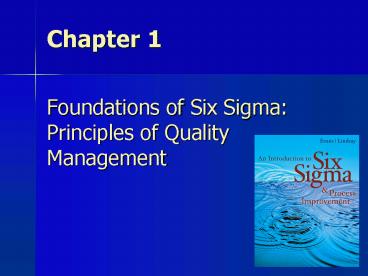Foundations of Six Sigma: Principles of Quality Management - PowerPoint PPT Presentation
1 / 20
Title:
Foundations of Six Sigma: Principles of Quality Management
Description:
Plant managers reduce waste, improve product consistency, solve equipment ... from companies such as GE, Allied Signal, 3M, Xerox, Raytheon, Citibank, and ... – PowerPoint PPT presentation
Number of Views:988
Avg rating:3.0/5.0
Title: Foundations of Six Sigma: Principles of Quality Management
1
Chapter 1
- Foundations of Six Sigma Principles of Quality
Management
2
What is Six Sigma?
Six Sigma can be described as a business
improvement approach that seeks to find and
eliminate causes of defects and errors in
manufacturing and service processes by focusing
on outputs that are critical to customers and a
clear financial return for the organization. Six
Sigma was pioneered by Motorola in the mid-1980s
and popularized by the success of General
Electric.
3
Six Sigma Methodology
- DMAIC
- Define
- Measure
- Analyze
- Improve
- Control
- Incorporates a wide variety of statistical and
process improvement tools
4
Key Concepts of Six Sigma (1 of 2)
- Think in terms of key business processes,
customer requirements, and overall strategic
objectives. - Focus on corporate sponsors responsible for
championing projects, support team activities,
help to overcome resistance to change, and
obtaining resources. - Emphasize such quantifiable measures as defects
per million opportunities (dpmo) that can be
applied to all parts of an organization
5
Key Concepts of Six Sigma (2 of 2)
- Ensure that appropriate metrics are identified
early and focus on business results, thereby
providing incentives and accountability. - Provide extensive training followed by project
team deployment - Create highly qualified process improvement
experts (green belts, black belts, and
master black belts) who can apply improvement
tools and lead teams. - Set stretch objectives for improvement.
6
Six Sigma Works for Everyone
- Plant managers reduce waste, improve product
consistency, solve equipment problems, create
capacity - Human resource managers reduce cycle time for
hiring processes - Sales managers improve forecast reliability,
pricing strategies, pricing variation - Anyone better understand customer needs and
tailor service offerings to meet them
7
Quality Management and the Evolution of Six Sigma
(1 of 3)
- Skilled craftsmanship during Middle Ages
- Industrial Revolution rise of inspection and
separate quality departments - Early 20th Century statistical methods at Bell
System - Quality control during World War II
- Post-war Japan evolution of quality management
8
Quality Management and the Evolution of Six Sigma
(2 of 3)
- Quality awareness in U.S. manufacturing industry
during 1980s from Little Q to Big Q - Total
Quality Management - Malcolm Baldrige National Quality Award (1987)
- Disappointments and criticism
9
Quality Management and the Evolution of Six Sigma
(3 of 3)
- Emergence of quality management in service
industries, government, health care, and
education - Birth of Six Sigma
- Current and future challenge keep progress in
quality management alive
10
Six Sigma vs. TQM
- Six Sigma
- Owned by business leader champions
- Cross functional projects
- Rigorous and advanced statistical tools
- Requires verifiable return on investment
- TQM
- Based on worker empowerment and teams
- Department or workplace focus
- Simple improvement tools
- Little financial accountability
11
Formal Definitions of Quality
- Design perspective quantities of product
attributes - Customer perspective fitness for intended use
- Operations perspective conformance to
specifications
12
Customer-Driven Quality
- Meeting and exceeding customer expectations
- Customers
- Consumers
- External customers
- Internal customers
13
Principles of Total Quality
- Focus on customers
- Participation and teamwork
- Process focus supported by continuous improvement
14
Customer Focus
- Customer is principal judge of quality
- Organizations must first understand customers
needs and expectations in order to meet and
exceed them - Organizations must build relationships with
customers
15
Customer Focus in Six Sigma
To meet or exceed customer expectations,
organizations must fully understand all product
and service attributes that contribute to
customer value and lead to satisfaction and
loyalty called critical to quality (CTQ)
characteristics. CTQs represent the important
drivers of Six Sigma improvement efforts.
16
Participation and Teamwork
- Employees know their jobs best and therefore, how
to improve them - Management must develop the systems and
procedures that foster participation and teamwork - Empowerment better serves customers, and creates
trust and motivation - Teamwork and cross-functional cooperation
encourage employee involvement and lead to more
effective problem solving
17
Process Focus and Continuous Improvement
- A process is a sequence of activities that is
intended to achieve some result
18
Continuous Improvement
- Enhancing value through new products and services
- Reducing errors, defects, waste, and costs
- Increasing productivity and effectiveness
- Improving responsiveness and cycle time
performance
19
Synergies Among Response Time, Quality, and
Productivity
Major improvements in response time may require
significant simplification of work processes and
often drive simultaneous improvements in quality
and productivity.
20
Six Sigma and Business Results
Considerable evidence exists that Six Sigma
initiatives positively impact bottom-line results
from companies such as GE, Allied Signal, 3M,
Xerox, Raytheon, Citibank, and many others.































